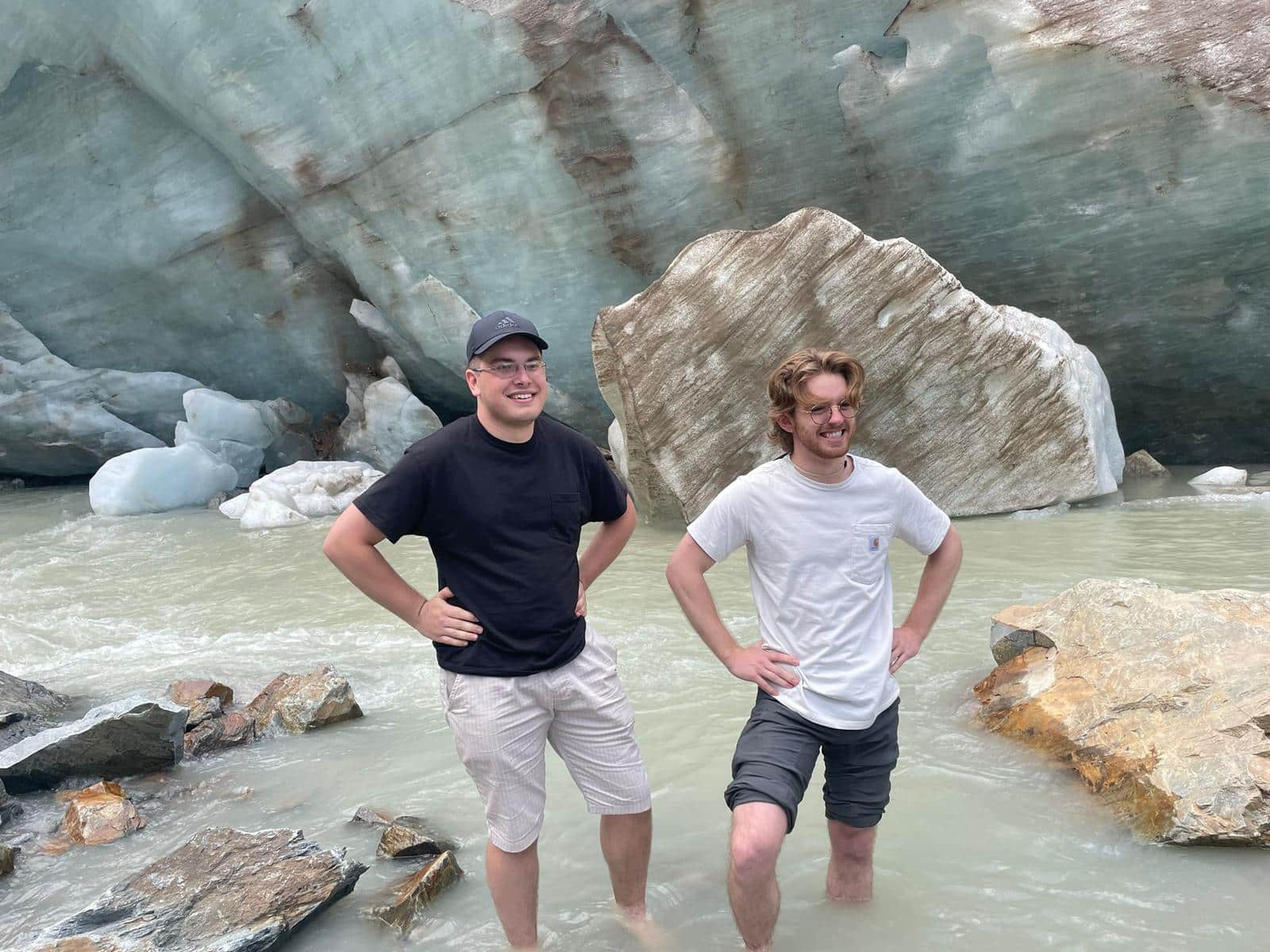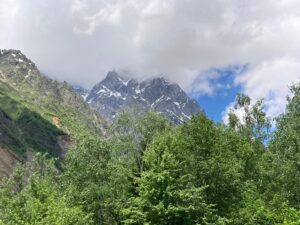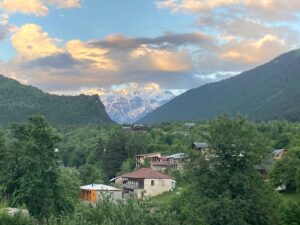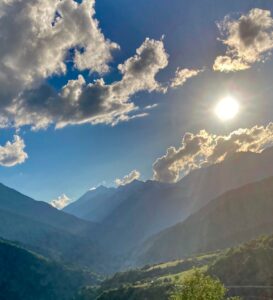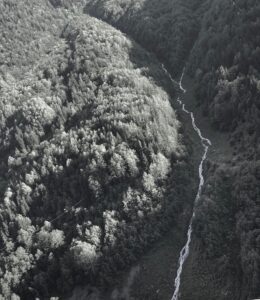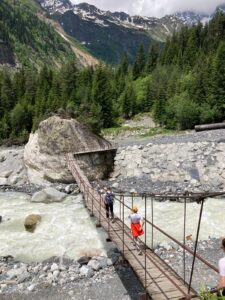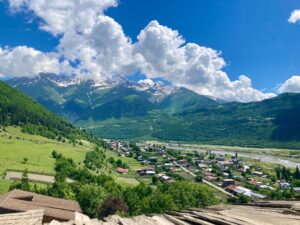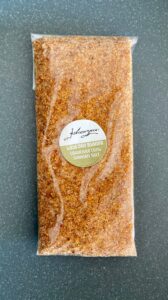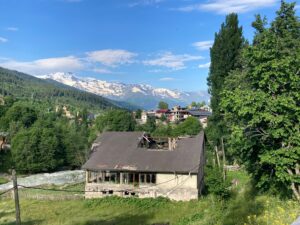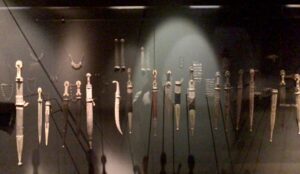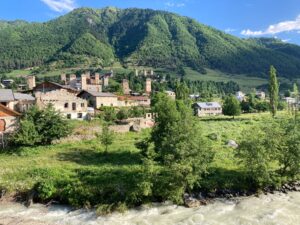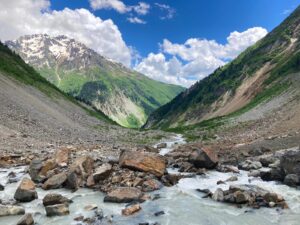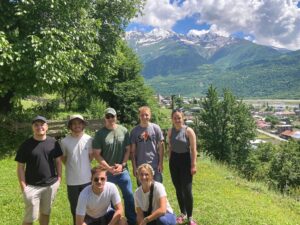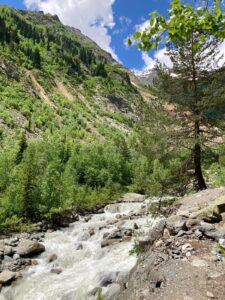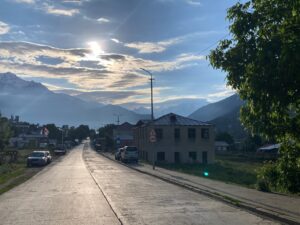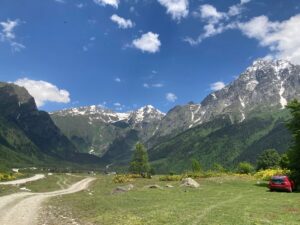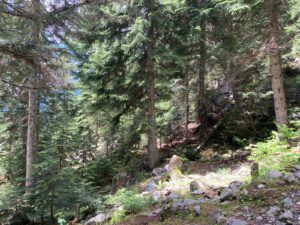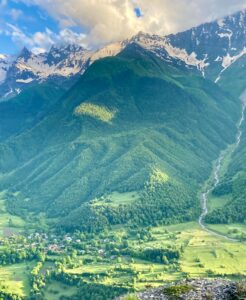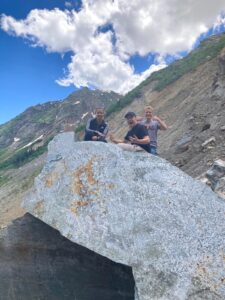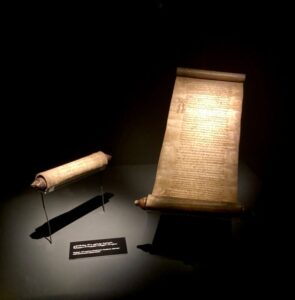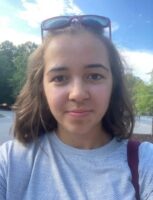As part of the SRAS/NovaMova study abroad program in Georgia, we had a weekend excursion to Svaneti during our third week. We had previously spent time in a couple different regions and cities, including Tbilisi, Mtskheta, and Khareba, but this was the first time our group saw the mountains of Georgia, a true natural wonder. We drove up to Mestia, the primary town of upper Svaneti, on Friday after classes, spent Saturday hiking and exploring, and left Sunday after breakfast. This entry will go over Svaneti’s history, some interesting facts, and reflect on our group’s time there.
Geography and History of Svaneti
Svaneti is a region in northwest Georgia. Located on the southern slopes of the central Caucasus Mountain range, the province is home to four of the ten highest peaks in the Caucasus and to Georgia’s highest, Mt. Shkhara. At 17,059 feet, it is about a half mile higher than Mt. Whitney in California, the highest peak in the continental US.
Svaneti is divided into Zemo Svaneti (upper) and Kvemo Svaneti (lower) by the Svaneti Range. Each region is dominated by a river that feeds its agriculture, and each has a separate history and identity. Upper Svaneti is marked by distinctive towers that served as both living spaces and defensive structures. Most were built between the 9th and 12th centuries and helped support freer, more independent communities for many centuries. Lower Svaneti has been historically more attached to larger empires and kingdoms.
Mention of the Svan peoples first appeared in 7 BC by Greek geographer Strabo. At the time, the Svan lands were part of the Kingdom of Colchis, also known as the “the land of the golden fleece” in Greek mythology. When Colchis fell apart, the lands were conjoined to the Roman province of Lazica. Svaneti was later part of the Abkhazian Kingdom in the 9th century until both joined the Kingdom of Georgia in the 11th century. That kingdom collapsed in the 1600s, leaving the Svan peoples, especially in the upper region, to form their own independent communities and smaller principalities. This lasted until the mid-1800s, when Russia took over the region. It remained under the control of Russia and then the USSR until the Soviet Union’s collapse in 1991 at which point it became part of independent Georgia.
The Svan Language
The Svan language is part of the family of Kartvelian languages, the other three being Georgian, Mingrelian, and Laz. There are also numerous dialects of Kartvelian languages. It is important to note that Svan is classed as its own language (not a dialect) and is not mutually intelligible with Georgian. Svan, along with many of the other local Caucasus languages, is regarded as an “increasingly endangered” language by UNESCO.
Svanetian Salt
Besides its gorgeous scenery, Svaneti is known for its special seasoning blend. In fact, it is arguably one of Georgia’s most well-known seasonings. Called Lushnu Jim in Svan, the blend traditionally consists of salt, coriander, blue fenugreek, marigold, garlic, red pepper, and local caraway seed. As a result, Svanetian salt is also quite fragrant. The salt that is used to create the blend in Svaneti is from local caves, coarsely ground, and has a light pink-brown or orange-like color (depending on the variety) due to it containing trace amounts of manganese, potassium, and other elements. It is most often used on meats, fish, and potatoes as well as in soups. However, it often finds a place in just about any savory dish.
Mestia, The Village Center
Mestia is the main town of Zemo Svaneti at an elevation of 1500m above sea level (comparable to Denver, Colorado). Despite being the main town, it has only just under 2000 residents. Yet it is also home to the Svaneti Museum of History and Ethnography (founded 1936) which contains medieval weaponry (e.g. daggers, artillery), icons, artwork, medals, old coins, jewelry, books and manuscripts, textiles, and other important historical artifacts. I highly recommend visiting this museum if you find yourself in the region. Although small and unassuming, the simple lay-out and exhibition designs are perfect for telling the thousands-years-old history of the region’s people.
Hiking and Experiencing Svaneti
Our group spent Friday night in a guesthouse in the Mestia village center. On Saturday morning, we completed a four-hour round-trip hiking trek on the southern Caucasus to the Chalaadi Glacier.
We drove along the dirt road from our guesthouse to the Mestiachala River, where the trailhead begins. At this point, the valley splits: the main river flowing to the right leads to the Russian border while the valley on the left leads to the Chalaadi Glacier. In order to reach the latter, we had to cross a suspension bridge over the boisterous Mestiachala. There was a new hydroplant under construction on the left side of the bridge.
After crossing the bridge, we headed to the dirt trail. Tall, beautiful trees and stunning mountains surrounded us while the Chalaadi River ran in a gorge to our left. When we reached the end of the forest path, we stood on the edge of a large moraine that went up to the glacier – we could see it not too far off! We climbed over the rocks, sediment, and boulders that make up the moraine and had to be cautious as they often moved or slipped under our feet. After 40 minutes, we arrived at the Chalaadi Glacier. The glacier is also the starting point of its respective river, the one we hiked alongside, which eventually feeds into the Mestiachala River downstream. The glacier itself is fed by the Bzhedukhi, Chatini, and Dalaqori mountain streams.
Two of our students bravely took off their shoes and waded in the freezing water of the Chaladdi River by the base of the glacier. It was incredible to touch a glacier with my own hands since I had never even seen one in real life before. We rested there for 30 minutes, ate our packed lunch boxes, and admired the breathtaking scenery before returning back.
For dinner at the guesthouse, we were offered an array of foods including chicken soup, meatballs, potatoes, carrot salad, tomato and cucumber salad, a variety of cheeses and breads, and kasha (porridge) with fruit jams. Later in the evening, we went to the town center where several groups of children were performing traditional Svanetian and Georgian dances for the community on an outdoor stage. We left back for Batumi on Sunday morning, a trip of roughly 8 hours over winding roads. Our driver accidentally took a wrong turn which added an extra hour to the trip but resulted in an opportunity to see more awe-inspiring views and take more pictures.
Conclusion: Svaneti is a Must-See!
Svaneti is certainly a trip I will remember, and I hope to come back someday to complete a longer hike trek. The region, cradled between snow-capped mountains and forests, was unlike the other parts of Georgia I had seen. Mestia is a cozy town with a couple small shops, and despite its small size, it felt like there simply was not enough time to fully explore and appreciate it. But I suppose this begs the question, when in nature, is there ever enough time to truly appreciate how wonderful it is?

